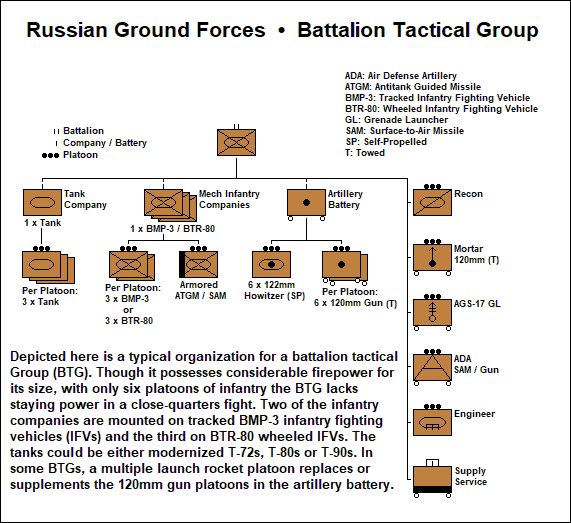As the Russian Army completes its preparations for a fresh offensive in the Donbas region of Ukraine, there have been many references to its battalion tactical groups (BTGs), of which 90-100 are said to be deployed. This, however, is a less than helpful factoid, since the size and composition of these units are not described. So here’s a quick take on the BTG.
In military parlance a BTG is a combined arms formation. That is, it embodies sub-units of various kinds: armor, mechanized infantry (called motorized rifle by the Russians), artillery, air defense artillery, combat engineers, etc.—the idea being to provide the BTG with all the assets it needs to execute its assigned mission.
Each tank and motorized rifle regiment or brigade embodies two or three BTGs, whose composition varies based on the parent unit. A typical one might have an armored company with ten-twelve tanks; three motorized rifle companies, each with two rifle platoons and a heavy weapons platoon; a composite artillery battery with twelve guns and howitzers; a mechanized reconnaissance company; and a variable number of support units, some permanently assigned, some attached as necessary. The BTG’s total strength is in the range of 800 officers and other ranks, around 250 of whom are in the motorized rifle companies.
The BTG is best thought of as the rapid reaction component of its parent unit. It is maintained at full strength and its troops are volunteer enlistees, better trained and more experienced than conscripted soldiers. In case of a major war the BTGs would deploy immediately as a covering force while the remainder of their parent units complete mobilization. They are also the preferred units for contingency operations—as the “special military operation” in Ukraine was supposed to be.
Insufficient infantry is the BTG’s main drawback, and it explains why the Russian offensive toward Kiev met with no success. Fighting on urban and semi-urban terrain against defending troops deployed in depth, tanks and other armored fighting vehicles (AFVs) are at a disadvantage. Fields of observation and fire are limited, rendering them vulnerable to well-positioned defenders armed with infantry antitank weapons. In that kind of fight, AFVs require close support from dismounted infantry and casualties are likely to be high. In the fighting north of Kyiv, many BTGs suffered just such heavy casualties thanks to their paucity of infantry, and were rendered combat ineffective.
It remains to be seen whether in the impending Donbas offensive the BTGs will meet with greater success. One thing, however, seems clear: The casualties suffered by these relatively elite units have had and will continue to have a disproportionately negative effect on the combat capacity of the Russian Army. And replacing experienced soldiers with poorly trained, inexperienced conscripts would accelerate rather than retard that inevitable decline.




Good description. I was trying to remember this from the dark days when we were fighting map wars against the Soviet army coming through the Fulda Gap. If these were truly elite units they wouldn't be having so much trouble with essentially light infantry. The Russian Army hasn't been asked to do mass formations for almost 80 years. This shows.
I guess elite means marching well in May Day parades.